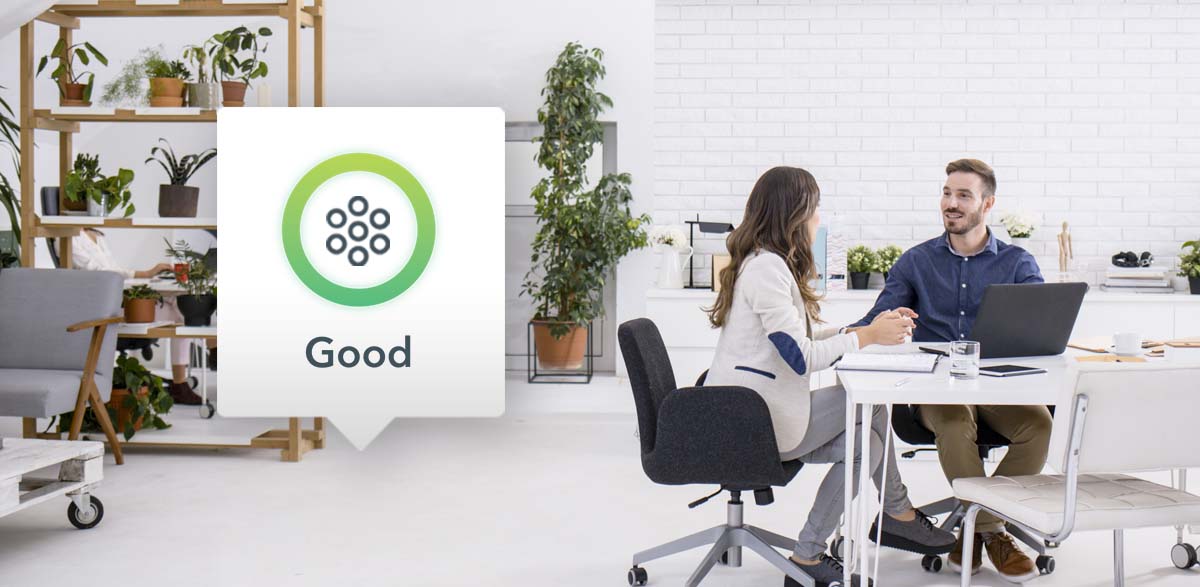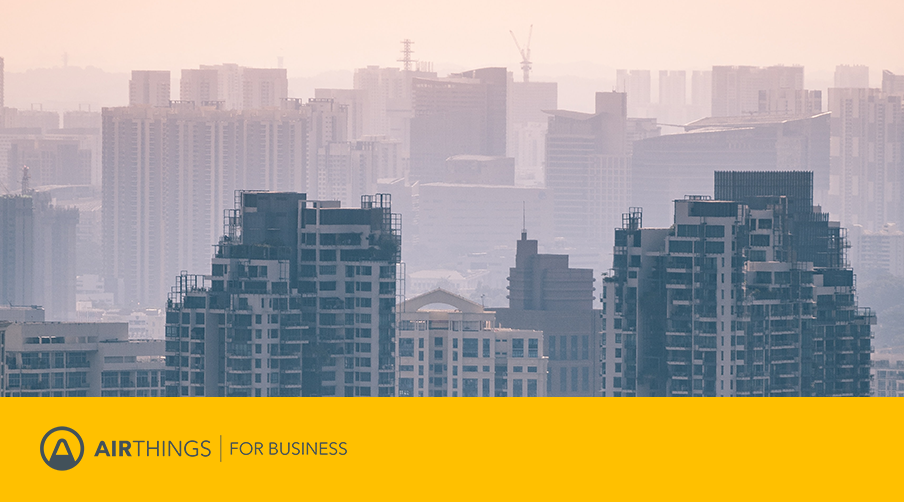Having good indoor air quality brings many benefits to your business.
Air pollution can be strange—it’s often invisible to the human eye, yet its impact on our health and productivity is extremely clear.
Every year, approximately 7 million people die from exposure to fine particles in polluted air.[1] To make matters more concerning, the World Health Organization (WHO) recently warned that some air pollutants are even more harmful than we thought.[2]
Because of this, good indoor air quality is becoming a more urgent priority for businesses, especially those in large cities. By ensuring that your workplace is safe and comfortable, you can actively demonstrate that you care about this issue—boosting staff morale and retention in the process.
This article shares some of the key topics businesses should know about when it comes to city air pollution.
In this blog:
- Air pollution in cities: the essential facts
- How does air pollution in cities affect employees?
- What can businesses and organizations do about city pollution?
 Air pollution in cities: the essential facts
Air pollution in cities: the essential facts
Air pollution, put simply, is the presence of harmful substances in the atmosphere. In cities, these substances mostly come from road transport (diesel and petrol vehicles in particular), but they may also be released from industrial processes.[3]
According to the United States Environmental Protection Agency (EPA), there are 6 common substances that contribute to air pollution[4]:
Most of these pollutants are invisible. However, when carbon monoxide, nitrogen dioxide and airborne chemicals (VOCs) react with sunlight, smog can appear.[5] This is especially common in cities with warmer climates.
Overall, air pollution affects all cities—but some are more polluted than others. When it comes to the United States, Los Angeles, San Francisco, and Chicago have some of the highest levels of particulate matter in the country.[6] In the UK, it’s estimated that 30 towns and cities have exceeded the air pollution limits set by the WHO, including Manchester and London.[7]

How does air pollution in cities affect employees?
It affects their health and wellbeing
Air pollution is harmful to everyone, but it can affect employees (and the businesses that hire them) in specific ways.
For instance, people who work indoors may be exposed to a higher level of particulate matter (PM), a pollutant that consists of solid and liquid particles.[8] This is especially likely in workplaces and offices with poor ventilation systems, as these particles can become trapped indoors with no way to leave. Once they’re inhaled, they can damage the respiratory system by causing inflammation to the airways, which may trigger asthma in some people.[9]
What’s more, the particles can also enter the bloodstream—potentially leading to heart problems.[10]
With high levels of PM in any given workplace, it’s impossible to maintain good air quality. This is a concern for businesses for two reasons. Firstly, poor air quality is statistically linked to a higher amount of sick days. In the UK, this equates to approximately 6 million days per year.[11] Secondly, new research suggests that long-term exposure to air pollution could increase the risk of COVID-19 hospitalization.[12] This can have a disruptive effect on your business activities.
Another way PM affects employees is the fact that it contributes to ‘sick building syndrome’. This is a term used to describe feelings of illness when inside a particular building.[13] In cities with high levels of air pollution, it may seem natural and intuitive to limit ventilation from outside (in an attempt to keep pollutants out). However, this could make matters worse. Since it’s already inevitable that pollutants will enter buildings, limiting air from outside will only keep indoor concentrations of pollutants higher than necessary.
Find out how companies improved their staff's health and wellbeing in our latest case studies➡️
It influences their productivity and performance
Other than health and wellbeing, air pollution also has a clear impact on employees’ productivity and performance—regardless of the type of work being done.
In the past, researchers have only focused on how air quality negatively affects manual labor.[14] However, there is now evidence that air pollution also makes office workers less productive.[15] In fact, a Harvard study concluded that well-ventilated office environments containing low amounts of airborne chemicals (VOCs) are linked to better cognitive performance.[16]
As previously mentioned, it’s important that businesses don’t limit airflow within buildings. This is to ensure that gases like radon and CO2 don’t continue to build up indoors.
What can businesses and organisations do about city pollution?
Businesses and organizations can take various actionable steps to improve city pollution. Firstly, you should monitor air pollution levels with a trustworthy and reliable system that can detect key pollutants, such as PM. Airthings for Business offers a complete indoor air quality solution to fit your needs, with sensors to detect PM, CO2, virus risk and more. What’s more, our monitors are RESET-accredited and can be used to satisfy some WELL standards.
Once you have a clear view of the indoor air quality at your place of business, you might want to ensure that your heating, ventilation and air conditioning (HVAC) systems are up to scratch or invest in more efficient and advanced systems.
Lastly, if you’re interested in making a lasting positive impact—not only for your workplace but also for surrounding organizations—you may choose to lobby your local or central government so they can better address the issue of city pollution. You can use your power as a business to demand change and improvement on this important issue.
Key takeaways
- Air pollution is the presence of harmful substances in the air. It is released from various substances, such as particulate matter (PM), carbon monoxide, and nitrogen dioxide.
- It has negative effects on employees’ health and wellbeing. PM, for instance, can cause respiratory and heart problems.
- Long-term exposure to air pollution may also negatively affect employees’ productivity and performance, as it can decrease cognitive function. Because of this, businesses should ensure good indoor air quality in workplaces for optimal results.
- Organizations should do three things to improve pollution: monitor their indoor air quality, ensure the quality of their ventilation systems, and lobby for change in their city.

[1] https://www.who.int/airpollution/data/en/
[2] https://www.bbc.co.uk/news/science-environment-58657224
[3] https://www.blf.org.uk/support-for-you/air-pollution/where-does-it-come-from
[4] https://www.epa.gov/criteria-air-pollutants
[5] https://www.sciencedirect.com/topics/earth-and-planetary-sciences/smog
[6] https://www.lung.org/research/sota/city-rankings/most-polluted-cities
[7] https://www.bbc.co.uk/news/health-43964341
[8] https://www.epa.gov/pm-pollution/particulate-matter-pm-basics
[9] www.ncbi.nlm.nih.gov/pmc/articles/PMC6635701/
[10] https://www.ncbi.nlm.nih.gov/pmc/articles/PMC4740122/
[11] https://www.rcplondon.ac.uk/news/research-shows-44-uk-cities-breach-world-health-organization-guidelines-air-pollution
[12] https://www.imperial.ac.uk/news/229233/long-term-pollution-linked-greater-risk-covid-19/
[13] https://www.nhs.uk/conditions/sick-building-syndrome/
[14] https://www.nber.org/system/files/working_papers/w19944/w19944.pdf
[15] https://hbr.org/2016/09/air-pollution-is-making-office-workers-less-productive
[16] https://dash.harvard.edu/bitstream/handle/1/27662232/4892924.pdf?sequence=1
we dont measure ventilation.
 Most popular
Most popular
 NEW
NEW




 Radon
Radon
 Radon
Radon


.webp)

 Air pollution in cities: the essential facts
Air pollution in cities: the essential facts

